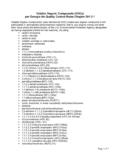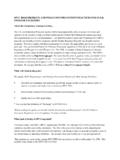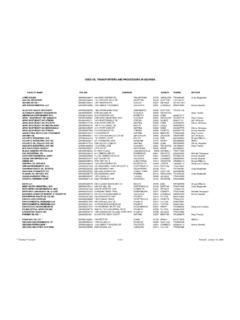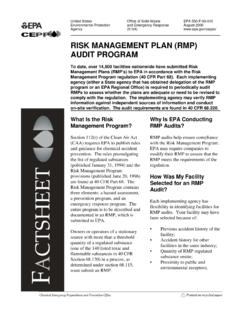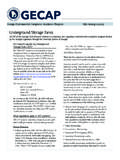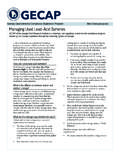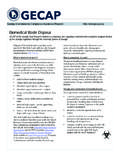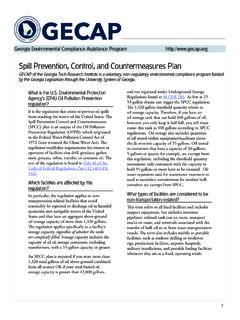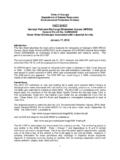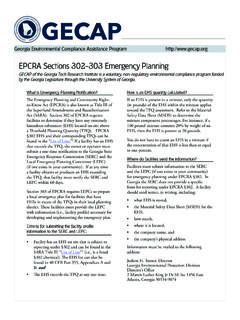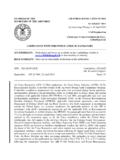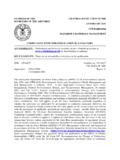Transcription of Georgia Department of Natural Resources - GECAP
1 GUST - 9 November, 2001 Georgia Department of Natural ResourcesEnvironmental Protection DivisionUnderground Storage Tank Management Program4244 International Parkway, Suite 104, Atlanta, Georgia 30354 Lonice C. Barrett, CommissionerHarold F. Reheis, Director(404)362-2687 UNDERGROUND STORAGE TANK (UST) CLOSURE GUIDANCEDOCUMENT--Petroleum Releases IT IS THE RESPONSIBILITY OF THE OWNER/OPERATOR TO SUBMITTHE CLOSURE THIS GUIDANCE DOCUMENT PRIOR TO REMOVING USTS. Forunderground storage tanks (USTs) and/or associated piping that are removed or permanently closedin-place, a Closure Report or Corrective Action Plan (CAP)-Part A, as applicable, must be prepared. If the UST Closure Report is submitted alone or as part of a CAP-Part A, follow these guidelinesfor closure procedures, sampling, excavation, disposal, and reporting.
2 A CAP-Part A must be submitted within sixty days (60) of the date that free product is observed inthe environment or that laboratory sample analysis results are received, unless it is demonstratedthat groundwater has not been impacted above applicable water quality standards (through clean[below detection limits] soil samples or a groundwater sample) AND soil contamination does notexceed applicable threshold levels and the site is eligible for No Further Action Required. If a CAP-A is required, include a complete closure report form and supporting documentation in the the site is eligible for No Further Action status, a Closure Report (including the attached ClosureReport Form) must be submitted to Environmental Protection Division (EPD) within forty-five (45)days after removal or in-place decommissioning of the USTs, and a copy must be retained by theowner or operator for at least three (3) years.
3 Consult this guidance document to determine which type of report must be prepared and submitted. Adhering to the following guidance will expedite the review of your file. The original signature of the UST owner is required on the closure report form. Original chains-of-custody signed by the sampler and receiving laboratory and original laboratory data sheets signedby the laboratory chemist must be ACTIVITIES ARE NOT REIMBURSABLEGUST - 9iNovember, 2001 TABLE OF CLOSURE OF .. AND EQUIPMENT REQUIRING PERMANENT CLOSURE .. TO SUBMIT TO THE EPD PRIOR TO AGENCIES TO NOTIFY PRIOR TO UST CLOSURE .. COLLECTION AND ANALYSES ANALYTICAL 21.)SOIL 62.)GROUNDWATER AND GROUNDWATER SAMPLE COLLECTION 121.
4 SOIL 122.)GROUNDWATER AND LOCATION OF SOIL AND GROUNDWATER 131.)SOIL SAMPLES FROM UST 13a)BEDROCK 142.)IF OVER-EXCAVATION IS 143.)SOIL SAMPLES FROM BELOW PIPING TRENCH AND 154.)GROUNDWATER 16a)REQUIRED GROUNDWATER 16b)GROUNDWATER SAMPLING TO REDUCE SOIL 16c) ADVANTAGES OF GROUNDWATER AND OF CONTAMINATED FOR "NO FURTHER ACTION REQUIRED" (NFAR) ACTION PLAN (CAP) PART 27 VII. REQUIREMENTS FOR RELEASE 28 VIII. UST CLEANING AND OF UNDERGROUND STORAGE 29 GUST - 9iiNovember, 2001 TABLESTABLE 9 LABORATORY METHODS FOR SOIL AND GROUNDWATER 9 TABLE 11 LABORATORY ESTIMATED QUANTITATION LIMITS FOR SOIL AND GROUNDWATER 11 APPENDICESAPPENDIX ACLOSURE ACTIVITY FORM (GUST-29)APPENDIX BSUMMARY OF METHOD 5035 SOIL SAMPLING PROCEDURESAPPENDIX CSAMPLE AFFIDAVITAPPENDIX DTABLE A AND TABLE B SOIL THRESHOLD LEVELSAPPENDIX EREPORT REVIEW STATISTICSAPPENDIX FLOCAL WATER SUPPLY SURVEYAPPENDIX GCLOSURE REPORT FORMGUST - 91 November, 2001I.
5 PERMANENT CLOSURE OF USTSA. INTRODUCTIONUSTs may be permanently closed by removing them from the ground or by fillingthe empty tanks with an inert solid material, such as sand, a mixture of sand and earth,foam, or concrete. The inert material must not react with the UST or its contents orallow leaching of residual petroleum from the UST. Permanent closure of product pipingmay be accomplished by emptying and removing the piping and capping the ends. Ifclosed in- place, the piping must first be flushed into the UST prior to emptying the UST. In most cases, the EPD recommends removal of the entire UST system. It isrecommended that in-place closure should be reserved for situations in which a structure,such as the foundation of a building or roadway, would be jeopardized by removal of theUST(s).
6 (For additional guidance on UST closure, refer to 40 CFR Part ) Note:Water is not an inert solid material and cannot be used for in-place of the inherent dangers in handling tanks (for example, explosive vaporsand potentially hazardous petroleum residuals) EPD recommends that only qualified andexperienced personnel close UST systems. The Occupational Safety and HealthAdministration (OSHA) requires that when it is reasonably possible that personnel mayencounter hazardous materials, such as petroleum1, and if personnel are conductingcorrective actions involving clean-up operations at sites covered by RCRA2, such as USTsites3, those personnel must complete forty hours of OSHA-approved health and safetytraining.
7 Petroleum is considered by OSHA to be a hazardous material in regards toOSHA regulations4. Knowledge of and experience with EPA sampling procedures,industry standards, and OSHA regulations (29 CFR Part 1910 and Part 1926) areessential. Fatalities have resulted from mistakes made during tank closures. In addition,improper handling of the material in the USTs and piping can result in releases thatrequire costly cleanups. Mistakes in sample collection, handling and analysis can alsoresult in costly USTS AND EQUIPMENT REQUIRING PERMANENT CLOSUREThe Georgia Underground Storage Tank (GUST) Rules define an UST as any oneor a combination of tanks, including underground pipes connected thereto.
8 " Therefore,all references to a "tank" or a "UST" in this document refer to both the UST and itsassociated piping, , the UST system. A tank must be permanently closed if:! It has been temporarily closed for more than twelve months and does notmeet standards for new UST systems or the upgrade requirements for existingsystems;GUST - 92 November, 2001! It has been abandoned and is substandard (not upgraded);! It was in service on or after January 1, 1974, but taken out of service orabandoned before December 22, 1988 (whether there has been a release or not);! Some local Fire Safety Codes may not permit an UST to remain in the ground ifit is permanently out of service.
9 Consult your local fire safety official about FORMS TO SUBMIT TO THE EPD PRIOR TO CLOSURECLOSURE ACTIVITY FORM (GUST-29)At least 30 days prior to closing the UST, complete and submit an original signedGUST-29 to the Underground Storage Tank Management Program (USTMP). The formis included in Appendix ADDITIONAL AGENCIES TO NOTIFY PRIOR TO UST CLOSUREC ontact the local fire marshal and the Utilities Protection Center before beginningan UST closure. The fire marshal and sometimes other local governmental agencies havejurisdiction over USTs and may require their oversight during removal. State lawrequires you to notify the Utilities Protection Center at 1-(800)-282-7411 at least 72hours before you start to your local government agency about construction permit SAMPLE COLLECTION AND ANALYSES REQUIREMENTSThe purpose of sampling soil during UST removal is twofold: 1) to determine if contaminationhas migrated to the water table and 2) to determine whether soil contamination requires remediationbecause it poses a future threat or continuing threat to the groundwater quality.
10 In order to obtainrepresentative samples of soil and (if required) groundwater, collect the samples no later than 24 hoursafter the UST removal. The following sections outline the requirements for sample collection REQUIRED ANALYTICAL METHODSAll analyses must be performed by a laboratory, using EPA-approved SW-846methods (Test Methods for Evaluating Solid Waste, United States EnvironmentalProtection Agency, Office of Solid Waste and Emergency Response, SW-846, ThirdEdition, as revised). Approved EPA methods require the performance of certainsampling, analysis, and quality assurance and quality control procedures in the field andin the laboratory.
